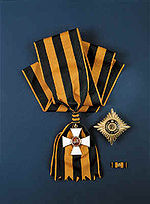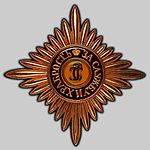- Order of St. George
-
For other uses, see Order of St. George (disambiguation).
The Military Order of the Holy Great-Martyr and the Triumphant George (also known as Order of St. George the Triumphant, Russian: Военный орден Св. Великомученика и Победоносца Георгия, Voyenny Orden Sviatago Velikomuchenika i Pobedonostsa Georgiya) is an order of chivalry of Imperial Russia, the White movement, and the Russian Federation, originally established in 1769 by Catherine the Great, and revived in 1994 by the Russian Federation. It is awarded in four classes, from the Fourth Degree to the First Degree. The highest degree is the First Degree. There also is an affiliated cross, the Cross of St. George and a medal which is a level lower than the cross.
Contents
Insignia
The decoration of the Order of St. George has to be worn according to its precedence (i.e. higher than any other decoration other than the Order of St. Andrew). The Order is composed of three insignia:
Cross ("Sign"): A white enamelled cross pattée with a central disc bearing the image of St. George on horseback slaying the dragon. Worn on a sash by the first degree, on a necklet by the second and third degrees, and on a chest ribbon by the fourth degree.
Star: A four-pointed gold star with the crowned cipher of St. George at the centre surrounded by the motto of the order "For Service and Bravery" ("Za Sluzhbu i Khrabrost"). Worn on the left chest by the first and second degrees.
Ribbon: orange with three black stripes, commonly called "George's Ribbon". It symbolises fire and gunpowder: the Russian "colors of military glory", and is also thought to be derived from the colours of the original Russian imperial coat of arms (black eagle on a golden background). It was subsequently associated to the colors of the Russian Guard units. The ribbon bar repeats the pattern of the grand ribbon, with a miniature cross on the middle black stripe for the first three degrees (white enamelled for the 3rd, silver for the 2nd and gold for the 1st).
History
This order was established in the Russian Empire on November 26, 1769 by Catherine the Great and had four degrees. It was abolished after the Russian Revolution of 1917, but was re-established on March 2, 1994 by the government of the Russian Federation. During the Great Patriotic War, the Order of Glory, modeled after the Order of St. George, was awarded to the Soviet military. Similar insignia was born by the Soviet medal For the Victory Over Germany.
Precedence
It is the highest military award of the Russian Federation, the highest decoration of all (military and civilian) being the Order of St. Andrew. "Hero of the Russian Federation" is on the other hand the highest title, marked by the award of a corresponding medal. However, the Order of St. George remains the most exclusive: only 25 people have been awarded the 1st rank of the Order (see list below). Of these, there were only four Full Cavaliers.
Eligibility: military officers and generals only, for the display of highest valour and skills in the face of an exterior enemy. This criterion was carried forward when the award was first reinstated in the Russian Federation. However, the statute was amended to permit the award of the order to senior commanders involved in the 2008 Georgia-Russia Conflict. Non-commissioned officers and rank-and-file may receive the Cross of St. George, also in four degrees worn on a chest ribbon. Normally a person initially received the fourth degree, and would gradually be promoted to higher degrees for subsequent acts of bravery.
List of recipients (1st degree)
- Empress Catherine the Great on November 26, 1769 (creating herself Grand Master of the Order upon its establishment)
- General en Chef Count Pyotr Alexandrovich Rumyantsev-Zadunaysky on July 27, 1770 (capture of Kagula during the Russo-Turkish War, 1768-1774; a few days later he was promoted to Field Marshal).
- General en Chef Count Aleksey Grigoryevich Orlov of Chesma on September 22, 1770 (Battle of Chesma).
- General en Chef Count Petr Ivanovich Panin on October 8, 1770 (capture of Bender).
- General en Chef Prince Vasili Vladimirovich Dolgorukov of the Crimea on July 18, 1771 (capture of the Crimea).
- General Field Marshal Prince Grigori Alexandrovich Potemkin of the Tauride on December 16, 1788 (Siege of Ochakov).
- General en Chef Count Alexander Vasilyevich Suvorov of Rymnik, later Prince of Italy, on October 18, 1789 (battle of the Rymnik during the Russo-Turkish War, 1787-1792; he was later promoted to General Field Marshal and later still, to Generalissimo).
- Admiral Vasili Yakovlevich Chichagov on July 27, 1790 (battles of Reval and Vyborg Bay during the Russo-Swedish War of 1788-1790).
- General en Chef Prince Nikolai Vasilyevich Repnin on July 15, 1791 (battle of Machin during the Russo-Turkish War of 1787-1792; he was later promoted to General Field Marshal).
- General Field Marshal Count (later Prince) Mikhail Illarionovich Kutuzov of Smolensk on December 12, 1812 (repelling Napoleon's invasion of Russia; Kutuzov was the first Full Cavalier of the Order).
- General of the Infantry, Count (later Prince) Michael Andreas Barclay de Tolly on August 19, 1813 (Battle of Kulm; he was later promoted to General Field Marshal).
- Crown Prince Charles John of Sweden on August 30, 1813 (Battle of Dennewitz, while in command of Russian forces).
- General Field Marshal (Prussia) Prince Gebhard Leberecht von Blücher of Wahlstatt on October 8, 1813 (Battle of Leipzig).
- General Field Marshal (Austria) Prince Charles Philip of Schwarzenberg on October 8, 1813 (Battle of Leipzig; Schwarzenberg and Blücher were the first foreigners to be awarded the Order while not holding rank or command in the Russian service)
- General Field Marshal Arthur Wellesley, 1st Duke of Wellington on April 28, 1814 (actions against the French in the course of the year; in 1815 he became Field Marshal of Russia).
- General of the Cavalry Levin August, count von Bennigsen on June 22, 1814 (actions against the French in the course of the year).
- Louis-Antoine, Duke of Angoulême on November 22, 1823 (intervention in Spain)
- General Adjutant Count Ivan Fedorovich Paskevich of Yerevan (later Prince of Warsaw) on July 27, 1829 (capture of Erzerum and victory in the Russo-Turkish War, 1828-1829; he was promoted to General Field Marshal a month later and was the fourth and the last Full Cavalier of the Order).
- General Adjutant Count Ivan Diebitsch-Zabalkansky on November 12, 1829 (victory in the Russo-Turkish War; he was later promoted to General Field Marshal).
- General Field Marshal (Austria, Russia) Count Joseph Radetzky on August 27, 1848 (recapture of Milan).
- Emperor Alexander II of Russia on November 26, 1869 (centennial of the Order)
- King Wilhelm I of Prussia on November 26, 1869 (centennial of the Order; he held a fourth-degree Order of St George for his actions during the war against Napoleon in 1814)
- General Field Marshal (Austria, Prussia and later, Russia) Archduke Albrecht of Austria on June 20, 1870 (Franco-Prussian War).
- General Adjutant Grand Duke Michael Nicolaevich of Russia on October 9, 1877 (actions during the Russo-Turkish War, 1877–78; he was later promoted to Field Marshal).
- General Adjutant Grand Duke Nicholas Nicolaievich of Russia the Elder on November 29, 1877 (capture of Pleven; he was later promoted to Field Marshal).
NOTE: all dates are Old Style.
See also
- Awards and decorations of the Russian Federation
- Order (decoration)
- Military decoration
Further reading
- Voennyĭ orden sviatogo velikomuchenika i pobedonostsa Georgiia: imennye spiski 1769 - 1920; biobibliograficheskiĭ spravochnik / otvetstvennyĭ sostavitel' V. M. Shabanov. Moskva 2004, ISBN 5-89577-059-2
External links
- "Orders of St. George". Catholic Encyclopedia. New York: Robert Appleton Company. 1913. http://www.newadvent.org/cathen/13350a.htm.
Categories:- Monarchical orders
- Orders of knighthood of Russia
- Military awards and decorations of Russia
- Order of Saint George
Wikimedia Foundation. 2010.


